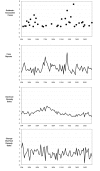Prediction of gastrointestinal disease with over-the-counter diarrheal remedy sales records in the San Francisco Bay Area
- PMID: 20646311
- PMCID: PMC2920250
- DOI: 10.1186/1472-6947-10-39
Prediction of gastrointestinal disease with over-the-counter diarrheal remedy sales records in the San Francisco Bay Area
Abstract
Background: Water utilities continue to be interested in implementing syndromic surveillance for the enhanced detection of waterborne disease outbreaks. The authors evaluated the ability of sales of over-the-counter diarrheal remedies available from the National Retail Data Monitor to predict endemic and epidemic gastrointestinal disease in the San Francisco Bay Area.
Methods: Time series models were fit to weekly diarrheal remedy sales and diarrheal illness case counts. Cross-correlations between the pre-whitened residual series were calculated. Diarrheal remedy sales model residuals were regressed on the number of weekly outbreaks and outbreak-associated cases. Diarrheal remedy sales models were used to auto-forecast one week-ahead sales. The sensitivity and specificity of signals, generated by observed diarrheal remedy sales exceeding the upper 95% forecast confidence interval, in predicting weekly outbreaks were calculated.
Results: No significant correlations were identified between weekly diarrheal remedy sales and diarrhea illness case counts, outbreak counts, or the number of outbreak-associated cases. Signals generated by forecasting with the diarrheal remedy sales model did not coincide with outbreak weeks more reliably than signals chosen randomly.
Conclusions: This work does not support the implementation of syndromic surveillance for gastrointestinal disease with data available though the National Retail Data Monitor.
Figures


Similar articles
-
Syndromic surveillance of gastrointestinal illness using pharmacy over-the-counter sales. A retrospective study of waterborne outbreaks in Saskatchewan and Ontario.Can J Public Health. 2004 Nov-Dec;95(6):446-50. doi: 10.1007/BF03403991. Can J Public Health. 2004. PMID: 15622795 Free PMC article.
-
Monitoring over-the-counter medication sales for early detection of disease outbreaks--New York City.MMWR Suppl. 2005 Aug 26;54:41-6. MMWR Suppl. 2005. PMID: 16177692
-
Detection of pediatric respiratory and diarrheal outbreaks from sales of over-the-counter electrolyte products.J Am Med Inform Assoc. 2003 Nov-Dec;10(6):555-62. doi: 10.1197/jamia.M1377. Epub 2003 Aug 4. J Am Med Inform Assoc. 2003. PMID: 12925542 Free PMC article.
-
Surveillance of gastrointestinal disease in France using drug sales data.Epidemics. 2014 Sep;8:1-8. doi: 10.1016/j.epidem.2014.05.001. Epub 2014 May 20. Epidemics. 2014. PMID: 25240898
-
Review of syndromic surveillance: implications for waterborne disease detection.J Epidemiol Community Health. 2006 Jun;60(6):543-50. doi: 10.1136/jech.2005.038539. J Epidemiol Community Health. 2006. PMID: 16698988 Free PMC article. Review.
Cited by
-
Drug sales data analysis for outbreak detection of infectious diseases: a systematic literature review.BMC Infect Dis. 2014 Nov 18;14:604. doi: 10.1186/s12879-014-0604-2. BMC Infect Dis. 2014. PMID: 25403237 Free PMC article.
-
Adapting Syndromic Surveillance Baselines After Public Health Interventions.Public Health Rep. 2020 Nov/Dec;135(6):737-745. doi: 10.1177/0033354920959080. Epub 2020 Oct 7. Public Health Rep. 2020. PMID: 33026959 Free PMC article.
-
Tracking Cholera through Surveillance of Oral Rehydration Solution Sales at Pharmacies: Insights from Urban Bangladesh.PLoS Negl Trop Dis. 2015 Dec 7;9(12):e0004230. doi: 10.1371/journal.pntd.0004230. eCollection 2015 Dec. PLoS Negl Trop Dis. 2015. PMID: 26641649 Free PMC article.
-
Substandard and Falsified Medicines: Proposed Methods for Case Finding and Sentinel Surveillance.JMIR Public Health Surveill. 2021 Aug 16;7(8):e29309. doi: 10.2196/29309. JMIR Public Health Surveill. 2021. PMID: 34181563 Free PMC article.
-
Gastroenteritis Forecasting Assessing the Use of Web and Electronic Health Record Data With a Linear and a Nonlinear Approach: Comparison Study.JMIR Public Health Surveill. 2023 Jan 31;9:e34982. doi: 10.2196/34982. JMIR Public Health Surveill. 2023. PMID: 36719726 Free PMC article.
References
-
- Rodman JS, Frost F. Pharmaceutical Sales--A Method of Disease Surveillance. J Environ Health. 1997;60
Publication types
MeSH terms
Substances
LinkOut - more resources
Full Text Sources
Medical

